Artificial Intelligence (AI) has come a long way in recent years, revolutionizing various industries and transforming the way we live and work. OpenAI, a leading research organization, has been at the forefront of developing cutting-edge AI models that push the boundaries of what is possible. One such model is OpenAI Sora, which has gained significant attention for its ability to generate mind-blowing videos.
What is OpenAI Sora?
OpenAI Sora is an advanced AI model developed by OpenAI. It is designed to generate highly realistic and visually stunning videos based on given prompts or instructions. Using a combination of deep learning techniques and a vast amount of training data, Sora can create videos that are indistinguishable from real footage.
Check OpenAI Sora
How does OpenAI Sora work?
OpenAI Sora utilizes a technique called generative adversarial networks (GANs) to generate videos. GANs consist of two neural networks: a generator and a discriminator. The generator is responsible for creating the videos, while the discriminator evaluates the generated videos and provides feedback to the generator to improve its output.
During the training process, OpenAI Sora is exposed to a large dataset of videos, allowing it to learn the patterns and characteristics of real-world footage. This enables the model to generate videos that exhibit similar qualities, including movement, lighting, and object interactions.
The Potential of OpenAI Sora
The capabilities of OpenAI Sora are truly remarkable. With this AI model, it is possible to generate videos that depict realistic scenes, scenarios, and even fictional narratives. This opens up a world of possibilities for various industries, including entertainment, advertising, and virtual reality.
In the entertainment industry, OpenAI Sora can be used to create stunning visual effects, realistic computer-generated characters, and immersive virtual environments. Filmmakers and game developers can leverage this technology to enhance their storytelling and create visually captivating experiences for their audiences.
For advertisers, OpenAI Sora offers the potential to create highly engaging and persuasive video advertisements. The AI model can generate product demonstrations, showcase different use cases, and even simulate real-world scenarios to showcase the benefits of a particular product or service.
Virtual reality (VR) is another area where OpenAI Sora can have a significant impact. By generating realistic virtual environments, Sora can enhance the immersion and realism of VR experiences. This can be particularly useful in training simulations, architectural visualization, and virtual tourism.
Ethical Considerations
While the capabilities of OpenAI Sora are impressive, it is important to consider the ethical implications of such technology. The ability to generate highly realistic videos raises concerns about the potential for misinformation and deepfakes.
OpenAI has taken steps to address these concerns by implementing strict usage policies and ethical guidelines. The organization is committed to ensuring responsible use of AI technology and actively collaborates with experts and policymakers to mitigate potential risks.
Furthermore, OpenAI Sora is not publicly available and is only accessible to a limited number of users. This helps to regulate its usage and prevent misuse of the technology.
Conclusion
OpenAI Sora represents a significant advancement in AI technology, particularly in the field of video generation. Its ability to create mind-blowing videos opens up new possibilities for various industries and applications. However, it is crucial to approach this technology with caution and ensure responsible use to prevent any negative consequences. As AI continues to evolve, it is essential to strike a balance between innovation and ethical considerations.


